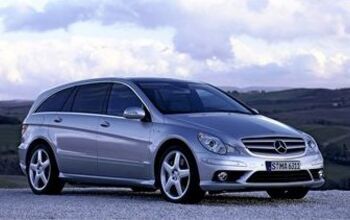Ask The Best And Brightest: Whither The Six Cylinder?
Detroit’s auto critics are a funny bunch. For decades they’ve been mocking the idea that Americans could ever love Europe’s small, underpowered, overpriced cars, as Detroit gorged itself on SUV profits. Now that Ford and GM have announced they’re bringing small cars like the Fiesta and Spark to the US, you’re starting to see the pendulum swing twice as hard in the opposite direction. “Yes, there will be a couple of mega-powerful V-8 asphalt eaters at the Detroit show, including the 2011 Cadillac CTS-V Coupe and the 2011 Ford Mustang GT 5.0,” writes Scott Burgess in a Detroit News piece entitled “ V-6 engines begin long fade into history.” “But, it turns out, destiny has determined that the meek four-banger will inherit the earth.” Burgess’s theory follows Ford’s Ecoboost playbook fairly closely: thanks to direct injection and turbocharging, smaller engines can produce more power. And when you consider that electric hybrids can restore some of the lost poke of a large-displacement engine, the prediction seems all the more likely. Eventually. But just because the new Sonata and Regal aren’t being offered with a V6, doesn’t mean the six-banger is ready for automotive Valhalla just yet. Even Burgess admits that “it may take 10 years or even more.” When do you, TTAC’s Best and Brightest, reckon the six-cylinder option on cars like the Camry, Altima or Impala will fall by the wayside? When will we see the death of the six-cylinder popular sportscar alá the Nissan Z?
Oh, and Burgess? Can we please stop calling all six-cylinder engines “V-6” now? It confuses the civilians, and everyone’s sick of correcting people when they say their car has a “V-4” even though it’s clearly not a classic Ford Taunus (etc).
Thanks, The Management
More by Edward Niedermeyer
Latest Car Reviews
Read moreLatest Product Reviews
Read moreRecent Comments
- Kosmo Resume the CTS V Wagon with 6MT!!!
- Ajla I'd also rather fix Jaguar. 😔
- Flashindapan I’m not an engineer but 30psi seems really high for factory turbo.
- Mike Beranek To have any shot at future relevance, Cadillac needs to lean into it's history and be itself. That means investing real money into differentiating them from the usual GM "parts bin" strategy.Build big cars with big, bespoke engines. Build a giant convertible with suicide doors. Build Escalades that aren't just Yukons with bling. Bring back the CT6, but make it available at a more reasonable price, to balance out the halo models.Build cars that famous people want to be seen in. That's what made Cadillac what it was.
- Wolfwagen Cadillac's naming scheme makes more sense than Lincoln's ever did


































Comments
Join the conversation
Turbocharged D.F.I V6s are the New V8s... but a Turbo+Supercharged I4 with DFI, VVT, should be what all manufacturers aim at in the near internal combustive future.
Having owned a 250-hp turbo'ed 4 (in a Saab) for 8 years, I can certainly say that, in transverse-mounted FWD applications, a 4 will get the job done for any reasonably-sized car. And the auto tranny in the Saab coupled with the engine management software means that about 85% of the time, you don't catch the turbo napping. In fact, when we shopped that car in '02, we test-drove the light-pressure turbo 200 hp 3-liter V-6, which drove inferior to the base model 185 hp turbo 4. That said, the Saab engine (which has a balance shaft) is pretty rough and gruff over 5,000 rpm. The fact is, however, that you never spend any time in that rpm range with that engine, and even at supra-legal (but sane) US highway cruising speeds, engine rpms are less than 2500, and abundant torque is available very quickly. I was fortunate enough to own for 10 years a car with the best V-6 ever, the 3 liter Yamaha SHO engine. The SHO was rated at less output than the Saab 4 and loved (needed) to rev. To be sure, it was smoother than the Saab 4, but the need to spool up to hit the power and torque, somewhat negated that advantage. In a RWD car, I don't see much of an argument for a V-6. The 3-liter BMW I-6 (which I now own in a Z3) is leagues ahead of either engine in smoothness and power delivery. Obviously, a transverse-mounted 3 liter I-6 has packaging problems. I think FWD (and AWD) has been greatly oversold, for mid-size and larger cars. And, as others have pointed out (and the Saab demonstrates vigorously, the SHO less so) torque steer is a significant issue with high power FWD applications (which is why Audi developed the "Quattro" AWD system in the first place. With traction and stability control systems being ubiquitous, the "advantages" of FWD in low-traction situations fade. So, I could imagine a future with 4-cylinder engines for FWD applications (with some sort of forced induction) and I-6 engines for RWD applications, with or without forced induction. As BWM's 300 hp, 3 liter twin-turbo'ed 6 demonstrates, it seems to me that the big V-8 is more questionable, except in supercars. In the historical curiousity department, recall that Porsche developed a 3-liter 4 cylinder engine for the RWD 944 car, later adding a multivalve head and ultimately a turbo, IIRC. That engine had a balance shaft. Never drove that car, but don't recall complaints about significant roughness, etc.